How the media distort the reality of crime
VerifiedAdded on 2022/08/20
|9
|2366
|12
AI Summary
Contribute Materials
Your contribution can guide someone’s learning journey. Share your
documents today.
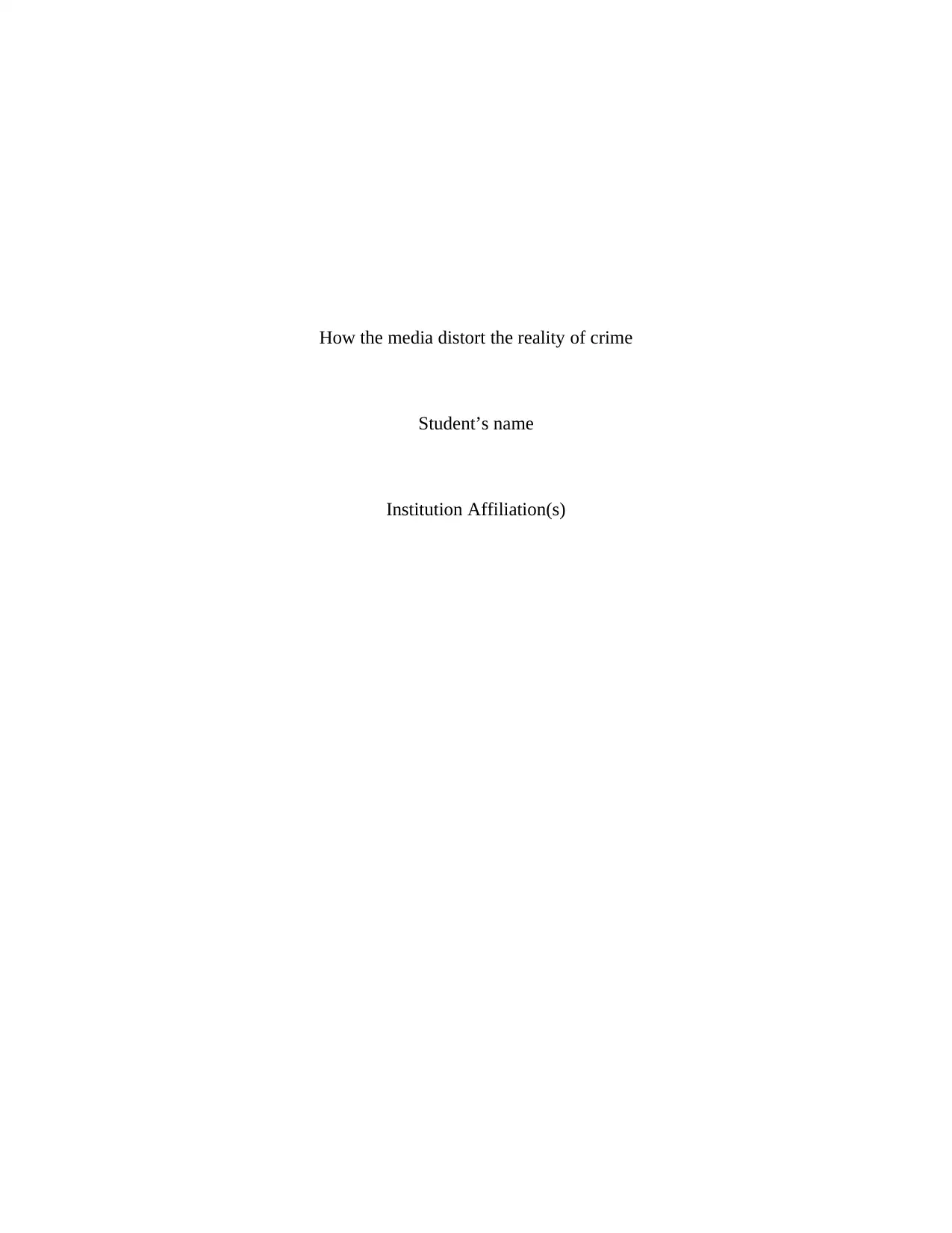
How the media distort the reality of crime
Student’s name
Institution Affiliation(s)
Student’s name
Institution Affiliation(s)
Secure Best Marks with AI Grader
Need help grading? Try our AI Grader for instant feedback on your assignments.
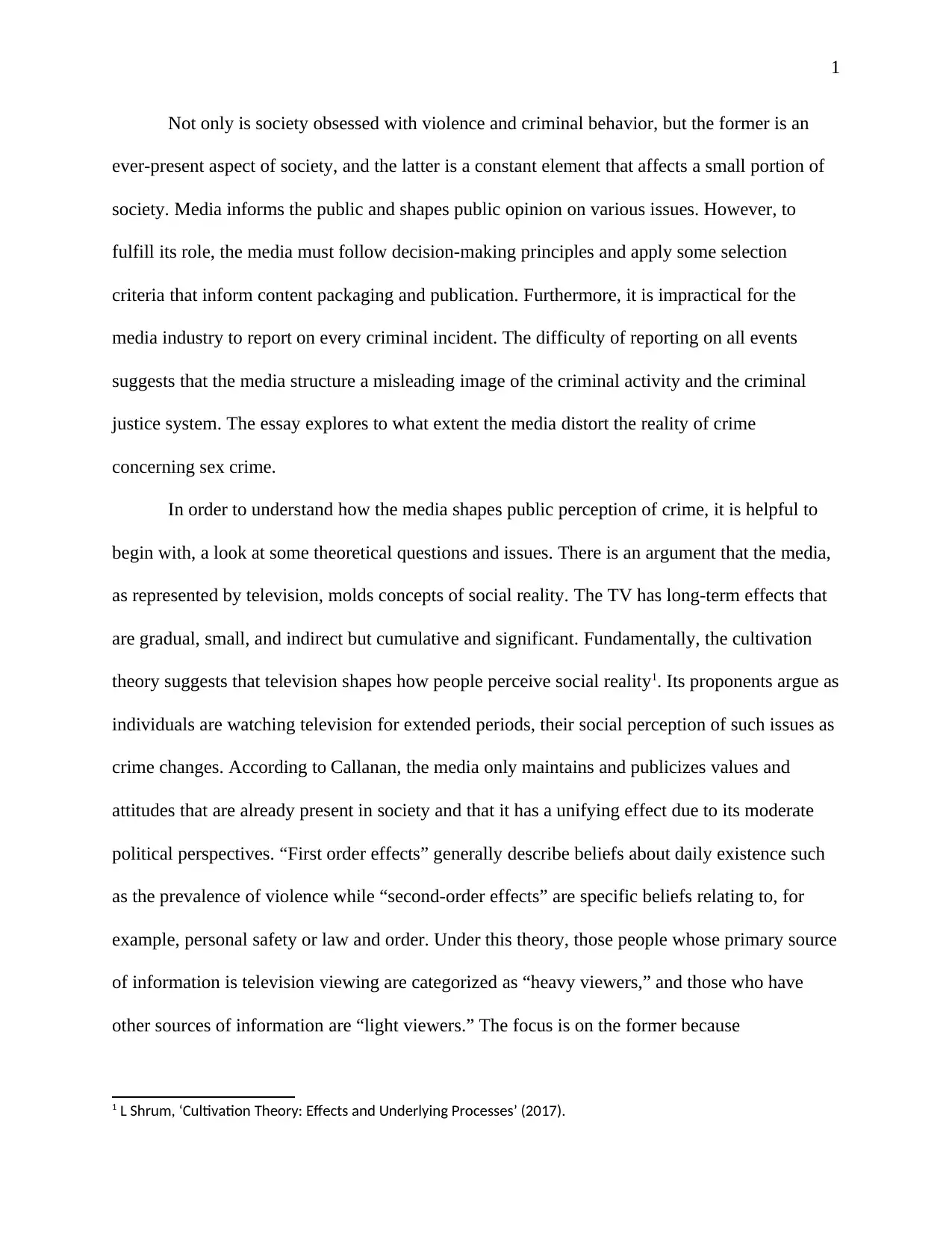
1
Not only is society obsessed with violence and criminal behavior, but the former is an
ever-present aspect of society, and the latter is a constant element that affects a small portion of
society. Media informs the public and shapes public opinion on various issues. However, to
fulfill its role, the media must follow decision-making principles and apply some selection
criteria that inform content packaging and publication. Furthermore, it is impractical for the
media industry to report on every criminal incident. The difficulty of reporting on all events
suggests that the media structure a misleading image of the criminal activity and the criminal
justice system. The essay explores to what extent the media distort the reality of crime
concerning sex crime.
In order to understand how the media shapes public perception of crime, it is helpful to
begin with, a look at some theoretical questions and issues. There is an argument that the media,
as represented by television, molds concepts of social reality. The TV has long-term effects that
are gradual, small, and indirect but cumulative and significant. Fundamentally, the cultivation
theory suggests that television shapes how people perceive social reality1. Its proponents argue as
individuals are watching television for extended periods, their social perception of such issues as
crime changes. According to Callanan, the media only maintains and publicizes values and
attitudes that are already present in society and that it has a unifying effect due to its moderate
political perspectives. “First order effects” generally describe beliefs about daily existence such
as the prevalence of violence while “second-order effects” are specific beliefs relating to, for
example, personal safety or law and order. Under this theory, those people whose primary source
of information is television viewing are categorized as “heavy viewers,” and those who have
other sources of information are “light viewers.” The focus is on the former because
1 L Shrum, ‘Cultivation Theory: Effects and Underlying Processes’ (2017).
Not only is society obsessed with violence and criminal behavior, but the former is an
ever-present aspect of society, and the latter is a constant element that affects a small portion of
society. Media informs the public and shapes public opinion on various issues. However, to
fulfill its role, the media must follow decision-making principles and apply some selection
criteria that inform content packaging and publication. Furthermore, it is impractical for the
media industry to report on every criminal incident. The difficulty of reporting on all events
suggests that the media structure a misleading image of the criminal activity and the criminal
justice system. The essay explores to what extent the media distort the reality of crime
concerning sex crime.
In order to understand how the media shapes public perception of crime, it is helpful to
begin with, a look at some theoretical questions and issues. There is an argument that the media,
as represented by television, molds concepts of social reality. The TV has long-term effects that
are gradual, small, and indirect but cumulative and significant. Fundamentally, the cultivation
theory suggests that television shapes how people perceive social reality1. Its proponents argue as
individuals are watching television for extended periods, their social perception of such issues as
crime changes. According to Callanan, the media only maintains and publicizes values and
attitudes that are already present in society and that it has a unifying effect due to its moderate
political perspectives. “First order effects” generally describe beliefs about daily existence such
as the prevalence of violence while “second-order effects” are specific beliefs relating to, for
example, personal safety or law and order. Under this theory, those people whose primary source
of information is television viewing are categorized as “heavy viewers,” and those who have
other sources of information are “light viewers.” The focus is on the former because
1 L Shrum, ‘Cultivation Theory: Effects and Underlying Processes’ (2017).
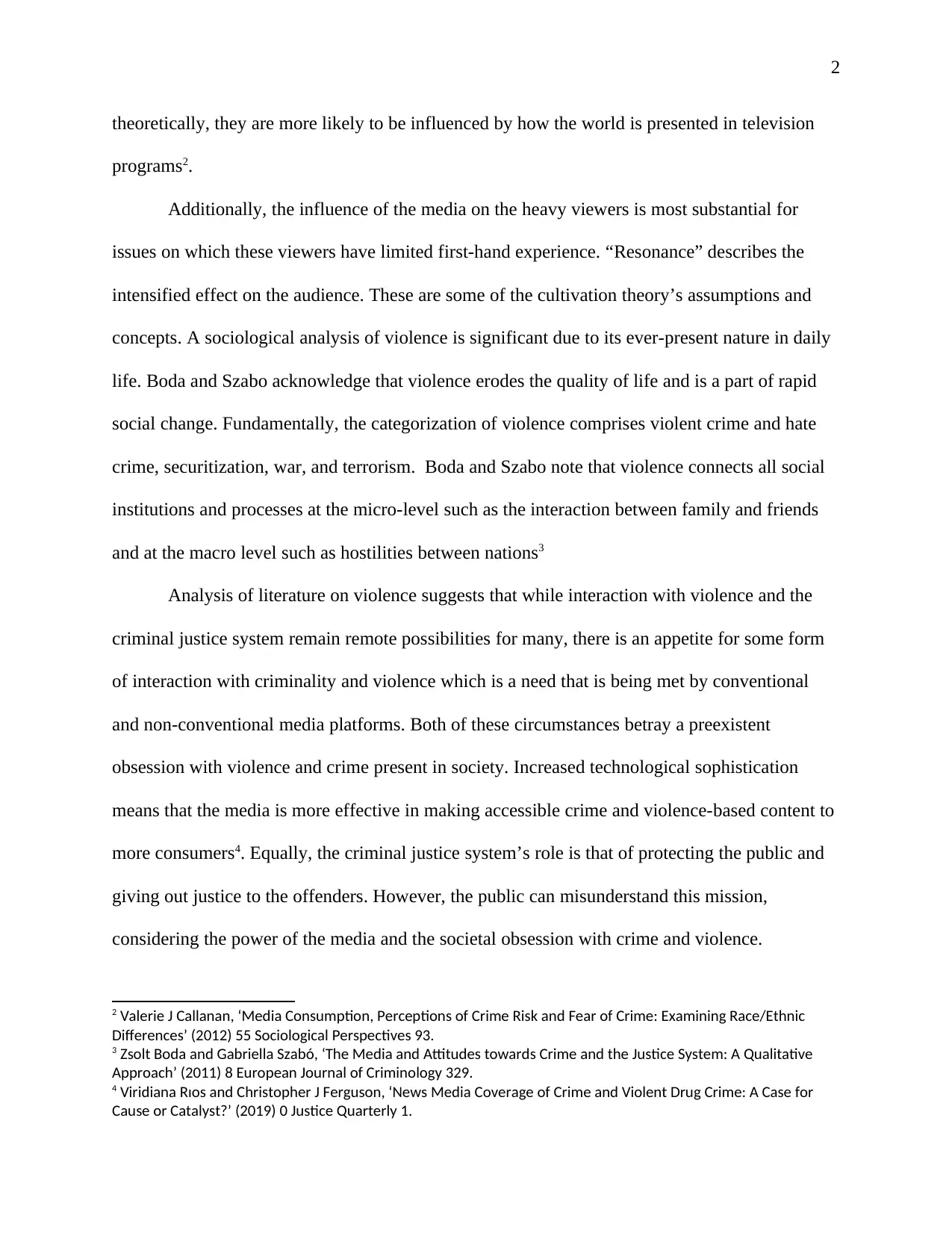
2
theoretically, they are more likely to be influenced by how the world is presented in television
programs2.
Additionally, the influence of the media on the heavy viewers is most substantial for
issues on which these viewers have limited first-hand experience. “Resonance” describes the
intensified effect on the audience. These are some of the cultivation theory’s assumptions and
concepts. A sociological analysis of violence is significant due to its ever-present nature in daily
life. Boda and Szabo acknowledge that violence erodes the quality of life and is a part of rapid
social change. Fundamentally, the categorization of violence comprises violent crime and hate
crime, securitization, war, and terrorism. Boda and Szabo note that violence connects all social
institutions and processes at the micro-level such as the interaction between family and friends
and at the macro level such as hostilities between nations3
Analysis of literature on violence suggests that while interaction with violence and the
criminal justice system remain remote possibilities for many, there is an appetite for some form
of interaction with criminality and violence which is a need that is being met by conventional
and non-conventional media platforms. Both of these circumstances betray a preexistent
obsession with violence and crime present in society. Increased technological sophistication
means that the media is more effective in making accessible crime and violence-based content to
more consumers4. Equally, the criminal justice system’s role is that of protecting the public and
giving out justice to the offenders. However, the public can misunderstand this mission,
considering the power of the media and the societal obsession with crime and violence.
2 Valerie J Callanan, ‘Media Consumption, Perceptions of Crime Risk and Fear of Crime: Examining Race/Ethnic
Differences’ (2012) 55 Sociological Perspectives 93.
3 Zsolt Boda and Gabriella Szabó, ‘The Media and Attitudes towards Crime and the Justice System: A Qualitative
Approach’ (2011) 8 European Journal of Criminology 329.
4 Viridiana Rıos and Christopher J Ferguson, ‘News Media Coverage of Crime and Violent Drug Crime: A Case for
Cause or Catalyst?’ (2019) 0 Justice Quarterly 1.
theoretically, they are more likely to be influenced by how the world is presented in television
programs2.
Additionally, the influence of the media on the heavy viewers is most substantial for
issues on which these viewers have limited first-hand experience. “Resonance” describes the
intensified effect on the audience. These are some of the cultivation theory’s assumptions and
concepts. A sociological analysis of violence is significant due to its ever-present nature in daily
life. Boda and Szabo acknowledge that violence erodes the quality of life and is a part of rapid
social change. Fundamentally, the categorization of violence comprises violent crime and hate
crime, securitization, war, and terrorism. Boda and Szabo note that violence connects all social
institutions and processes at the micro-level such as the interaction between family and friends
and at the macro level such as hostilities between nations3
Analysis of literature on violence suggests that while interaction with violence and the
criminal justice system remain remote possibilities for many, there is an appetite for some form
of interaction with criminality and violence which is a need that is being met by conventional
and non-conventional media platforms. Both of these circumstances betray a preexistent
obsession with violence and crime present in society. Increased technological sophistication
means that the media is more effective in making accessible crime and violence-based content to
more consumers4. Equally, the criminal justice system’s role is that of protecting the public and
giving out justice to the offenders. However, the public can misunderstand this mission,
considering the power of the media and the societal obsession with crime and violence.
2 Valerie J Callanan, ‘Media Consumption, Perceptions of Crime Risk and Fear of Crime: Examining Race/Ethnic
Differences’ (2012) 55 Sociological Perspectives 93.
3 Zsolt Boda and Gabriella Szabó, ‘The Media and Attitudes towards Crime and the Justice System: A Qualitative
Approach’ (2011) 8 European Journal of Criminology 329.
4 Viridiana Rıos and Christopher J Ferguson, ‘News Media Coverage of Crime and Violent Drug Crime: A Case for
Cause or Catalyst?’ (2019) 0 Justice Quarterly 1.
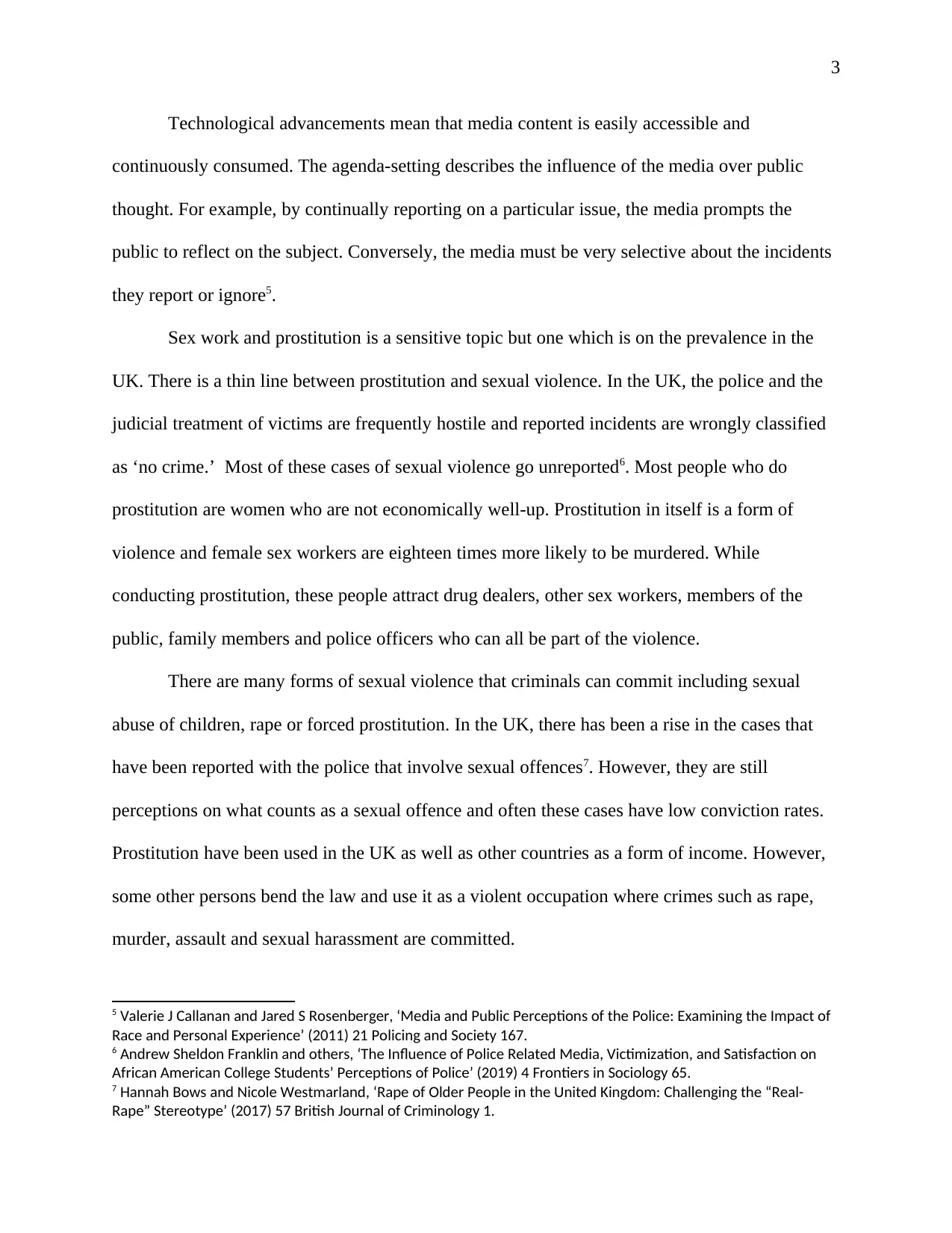
3
Technological advancements mean that media content is easily accessible and
continuously consumed. The agenda-setting describes the influence of the media over public
thought. For example, by continually reporting on a particular issue, the media prompts the
public to reflect on the subject. Conversely, the media must be very selective about the incidents
they report or ignore5.
Sex work and prostitution is a sensitive topic but one which is on the prevalence in the
UK. There is a thin line between prostitution and sexual violence. In the UK, the police and the
judicial treatment of victims are frequently hostile and reported incidents are wrongly classified
as ‘no crime.’ Most of these cases of sexual violence go unreported6. Most people who do
prostitution are women who are not economically well-up. Prostitution in itself is a form of
violence and female sex workers are eighteen times more likely to be murdered. While
conducting prostitution, these people attract drug dealers, other sex workers, members of the
public, family members and police officers who can all be part of the violence.
There are many forms of sexual violence that criminals can commit including sexual
abuse of children, rape or forced prostitution. In the UK, there has been a rise in the cases that
have been reported with the police that involve sexual offences7. However, they are still
perceptions on what counts as a sexual offence and often these cases have low conviction rates.
Prostitution have been used in the UK as well as other countries as a form of income. However,
some other persons bend the law and use it as a violent occupation where crimes such as rape,
murder, assault and sexual harassment are committed.
5 Valerie J Callanan and Jared S Rosenberger, ‘Media and Public Perceptions of the Police: Examining the Impact of
Race and Personal Experience’ (2011) 21 Policing and Society 167.
6 Andrew Sheldon Franklin and others, ‘The Influence of Police Related Media, Victimization, and Satisfaction on
African American College Students’ Perceptions of Police’ (2019) 4 Frontiers in Sociology 65.
7 Hannah Bows and Nicole Westmarland, ‘Rape of Older People in the United Kingdom: Challenging the “Real-
Rape” Stereotype’ (2017) 57 British Journal of Criminology 1.
Technological advancements mean that media content is easily accessible and
continuously consumed. The agenda-setting describes the influence of the media over public
thought. For example, by continually reporting on a particular issue, the media prompts the
public to reflect on the subject. Conversely, the media must be very selective about the incidents
they report or ignore5.
Sex work and prostitution is a sensitive topic but one which is on the prevalence in the
UK. There is a thin line between prostitution and sexual violence. In the UK, the police and the
judicial treatment of victims are frequently hostile and reported incidents are wrongly classified
as ‘no crime.’ Most of these cases of sexual violence go unreported6. Most people who do
prostitution are women who are not economically well-up. Prostitution in itself is a form of
violence and female sex workers are eighteen times more likely to be murdered. While
conducting prostitution, these people attract drug dealers, other sex workers, members of the
public, family members and police officers who can all be part of the violence.
There are many forms of sexual violence that criminals can commit including sexual
abuse of children, rape or forced prostitution. In the UK, there has been a rise in the cases that
have been reported with the police that involve sexual offences7. However, they are still
perceptions on what counts as a sexual offence and often these cases have low conviction rates.
Prostitution have been used in the UK as well as other countries as a form of income. However,
some other persons bend the law and use it as a violent occupation where crimes such as rape,
murder, assault and sexual harassment are committed.
5 Valerie J Callanan and Jared S Rosenberger, ‘Media and Public Perceptions of the Police: Examining the Impact of
Race and Personal Experience’ (2011) 21 Policing and Society 167.
6 Andrew Sheldon Franklin and others, ‘The Influence of Police Related Media, Victimization, and Satisfaction on
African American College Students’ Perceptions of Police’ (2019) 4 Frontiers in Sociology 65.
7 Hannah Bows and Nicole Westmarland, ‘Rape of Older People in the United Kingdom: Challenging the “Real-
Rape” Stereotype’ (2017) 57 British Journal of Criminology 1.
Secure Best Marks with AI Grader
Need help grading? Try our AI Grader for instant feedback on your assignments.
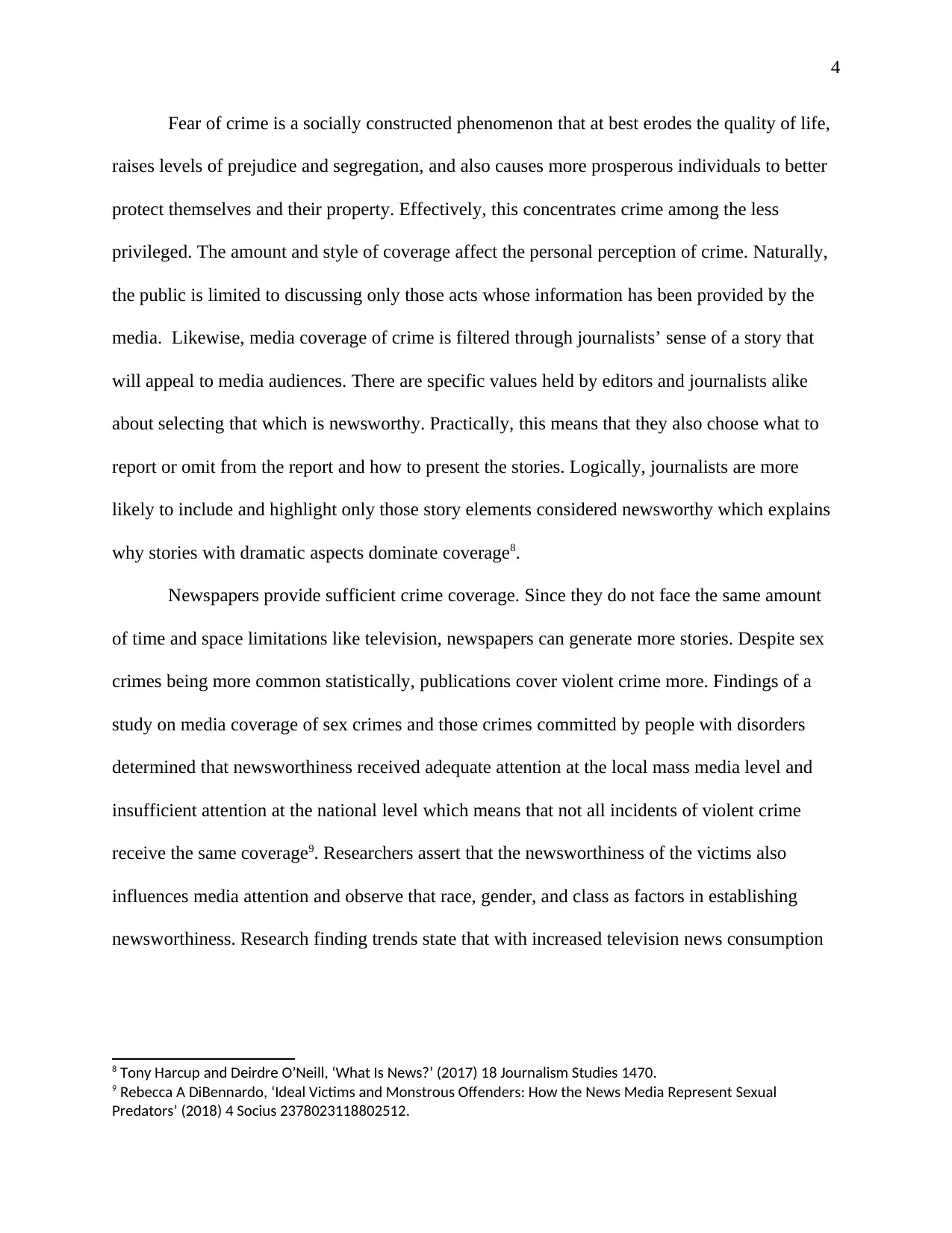
4
Fear of crime is a socially constructed phenomenon that at best erodes the quality of life,
raises levels of prejudice and segregation, and also causes more prosperous individuals to better
protect themselves and their property. Effectively, this concentrates crime among the less
privileged. The amount and style of coverage affect the personal perception of crime. Naturally,
the public is limited to discussing only those acts whose information has been provided by the
media. Likewise, media coverage of crime is filtered through journalists’ sense of a story that
will appeal to media audiences. There are specific values held by editors and journalists alike
about selecting that which is newsworthy. Practically, this means that they also choose what to
report or omit from the report and how to present the stories. Logically, journalists are more
likely to include and highlight only those story elements considered newsworthy which explains
why stories with dramatic aspects dominate coverage8.
Newspapers provide sufficient crime coverage. Since they do not face the same amount
of time and space limitations like television, newspapers can generate more stories. Despite sex
crimes being more common statistically, publications cover violent crime more. Findings of a
study on media coverage of sex crimes and those crimes committed by people with disorders
determined that newsworthiness received adequate attention at the local mass media level and
insufficient attention at the national level which means that not all incidents of violent crime
receive the same coverage9. Researchers assert that the newsworthiness of the victims also
influences media attention and observe that race, gender, and class as factors in establishing
newsworthiness. Research finding trends state that with increased television news consumption
8 Tony Harcup and Deirdre O’Neill, ‘What Is News?’ (2017) 18 Journalism Studies 1470.
9 Rebecca A DiBennardo, ‘Ideal Victims and Monstrous Offenders: How the News Media Represent Sexual
Predators’ (2018) 4 Socius 2378023118802512.
Fear of crime is a socially constructed phenomenon that at best erodes the quality of life,
raises levels of prejudice and segregation, and also causes more prosperous individuals to better
protect themselves and their property. Effectively, this concentrates crime among the less
privileged. The amount and style of coverage affect the personal perception of crime. Naturally,
the public is limited to discussing only those acts whose information has been provided by the
media. Likewise, media coverage of crime is filtered through journalists’ sense of a story that
will appeal to media audiences. There are specific values held by editors and journalists alike
about selecting that which is newsworthy. Practically, this means that they also choose what to
report or omit from the report and how to present the stories. Logically, journalists are more
likely to include and highlight only those story elements considered newsworthy which explains
why stories with dramatic aspects dominate coverage8.
Newspapers provide sufficient crime coverage. Since they do not face the same amount
of time and space limitations like television, newspapers can generate more stories. Despite sex
crimes being more common statistically, publications cover violent crime more. Findings of a
study on media coverage of sex crimes and those crimes committed by people with disorders
determined that newsworthiness received adequate attention at the local mass media level and
insufficient attention at the national level which means that not all incidents of violent crime
receive the same coverage9. Researchers assert that the newsworthiness of the victims also
influences media attention and observe that race, gender, and class as factors in establishing
newsworthiness. Research finding trends state that with increased television news consumption
8 Tony Harcup and Deirdre O’Neill, ‘What Is News?’ (2017) 18 Journalism Studies 1470.
9 Rebecca A DiBennardo, ‘Ideal Victims and Monstrous Offenders: How the News Media Represent Sexual
Predators’ (2018) 4 Socius 2378023118802512.
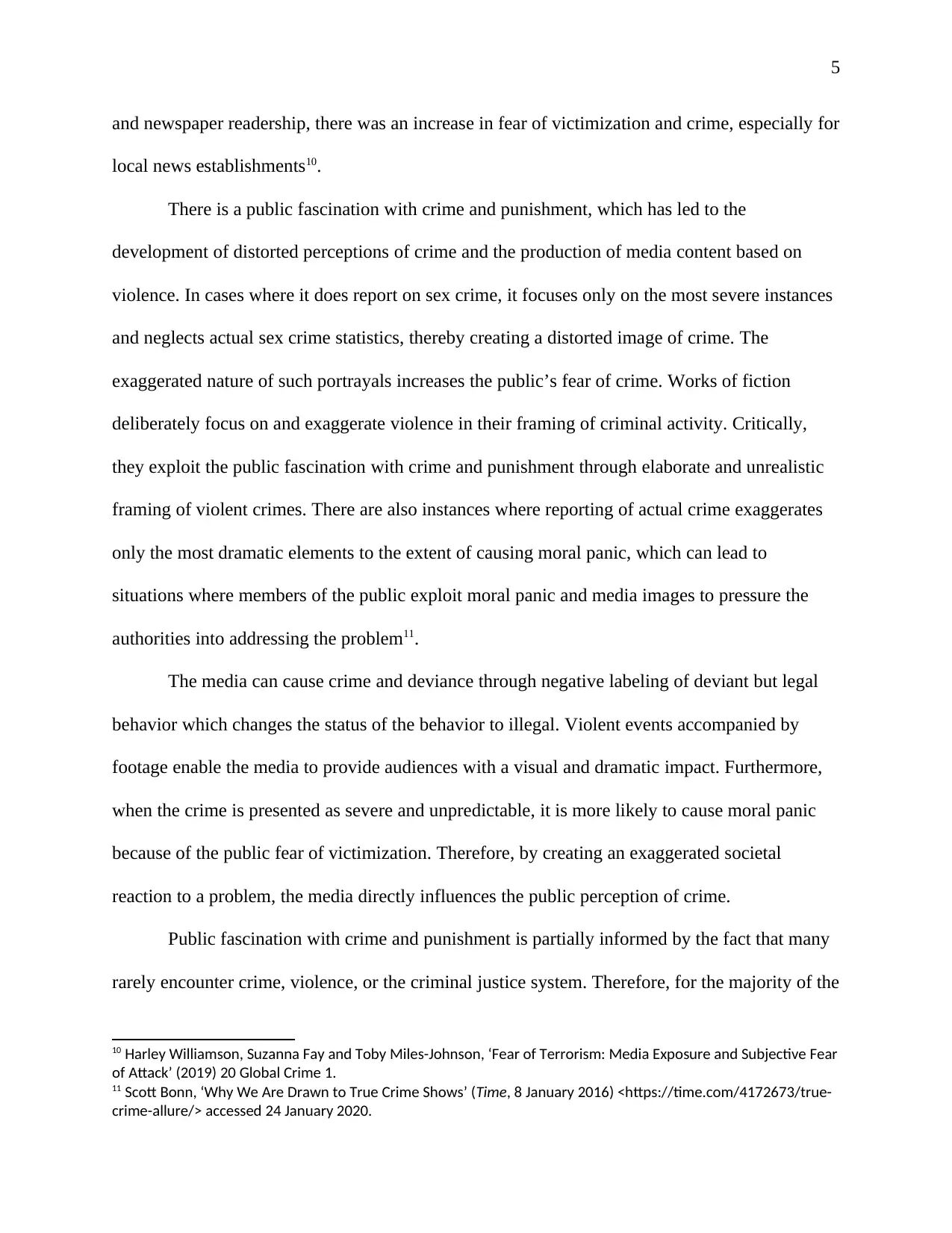
5
and newspaper readership, there was an increase in fear of victimization and crime, especially for
local news establishments10.
There is a public fascination with crime and punishment, which has led to the
development of distorted perceptions of crime and the production of media content based on
violence. In cases where it does report on sex crime, it focuses only on the most severe instances
and neglects actual sex crime statistics, thereby creating a distorted image of crime. The
exaggerated nature of such portrayals increases the public’s fear of crime. Works of fiction
deliberately focus on and exaggerate violence in their framing of criminal activity. Critically,
they exploit the public fascination with crime and punishment through elaborate and unrealistic
framing of violent crimes. There are also instances where reporting of actual crime exaggerates
only the most dramatic elements to the extent of causing moral panic, which can lead to
situations where members of the public exploit moral panic and media images to pressure the
authorities into addressing the problem11.
The media can cause crime and deviance through negative labeling of deviant but legal
behavior which changes the status of the behavior to illegal. Violent events accompanied by
footage enable the media to provide audiences with a visual and dramatic impact. Furthermore,
when the crime is presented as severe and unpredictable, it is more likely to cause moral panic
because of the public fear of victimization. Therefore, by creating an exaggerated societal
reaction to a problem, the media directly influences the public perception of crime.
Public fascination with crime and punishment is partially informed by the fact that many
rarely encounter crime, violence, or the criminal justice system. Therefore, for the majority of the
10 Harley Williamson, Suzanna Fay and Toby Miles-Johnson, ‘Fear of Terrorism: Media Exposure and Subjective Fear
of Attack’ (2019) 20 Global Crime 1.
11 Scott Bonn, ‘Why We Are Drawn to True Crime Shows’ (Time, 8 January 2016) <https://time.com/4172673/true-
crime-allure/> accessed 24 January 2020.
and newspaper readership, there was an increase in fear of victimization and crime, especially for
local news establishments10.
There is a public fascination with crime and punishment, which has led to the
development of distorted perceptions of crime and the production of media content based on
violence. In cases where it does report on sex crime, it focuses only on the most severe instances
and neglects actual sex crime statistics, thereby creating a distorted image of crime. The
exaggerated nature of such portrayals increases the public’s fear of crime. Works of fiction
deliberately focus on and exaggerate violence in their framing of criminal activity. Critically,
they exploit the public fascination with crime and punishment through elaborate and unrealistic
framing of violent crimes. There are also instances where reporting of actual crime exaggerates
only the most dramatic elements to the extent of causing moral panic, which can lead to
situations where members of the public exploit moral panic and media images to pressure the
authorities into addressing the problem11.
The media can cause crime and deviance through negative labeling of deviant but legal
behavior which changes the status of the behavior to illegal. Violent events accompanied by
footage enable the media to provide audiences with a visual and dramatic impact. Furthermore,
when the crime is presented as severe and unpredictable, it is more likely to cause moral panic
because of the public fear of victimization. Therefore, by creating an exaggerated societal
reaction to a problem, the media directly influences the public perception of crime.
Public fascination with crime and punishment is partially informed by the fact that many
rarely encounter crime, violence, or the criminal justice system. Therefore, for the majority of the
10 Harley Williamson, Suzanna Fay and Toby Miles-Johnson, ‘Fear of Terrorism: Media Exposure and Subjective Fear
of Attack’ (2019) 20 Global Crime 1.
11 Scott Bonn, ‘Why We Are Drawn to True Crime Shows’ (Time, 8 January 2016) <https://time.com/4172673/true-
crime-allure/> accessed 24 January 2020.
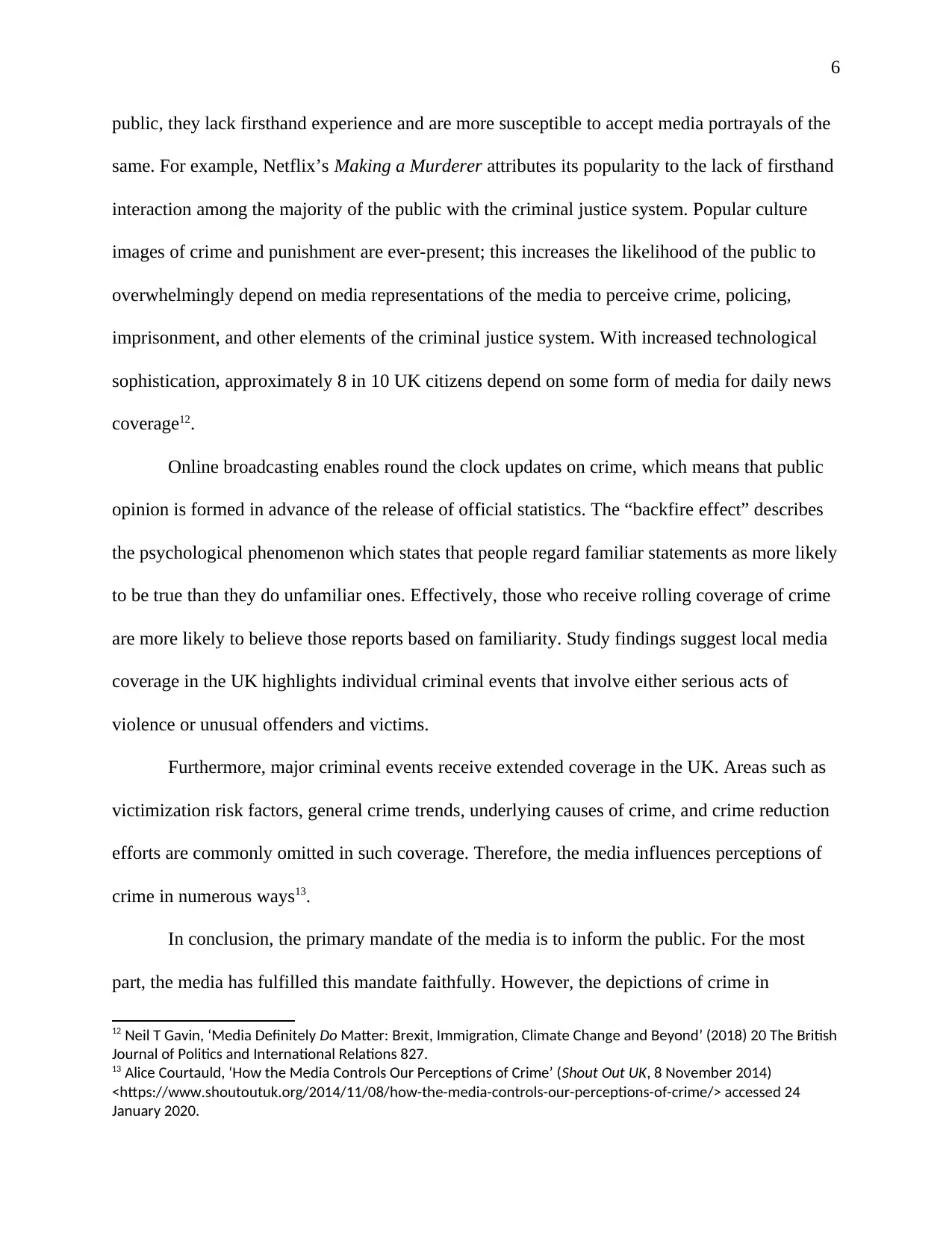
6
public, they lack firsthand experience and are more susceptible to accept media portrayals of the
same. For example, Netflix’s Making a Murderer attributes its popularity to the lack of firsthand
interaction among the majority of the public with the criminal justice system. Popular culture
images of crime and punishment are ever-present; this increases the likelihood of the public to
overwhelmingly depend on media representations of the media to perceive crime, policing,
imprisonment, and other elements of the criminal justice system. With increased technological
sophistication, approximately 8 in 10 UK citizens depend on some form of media for daily news
coverage12.
Online broadcasting enables round the clock updates on crime, which means that public
opinion is formed in advance of the release of official statistics. The “backfire effect” describes
the psychological phenomenon which states that people regard familiar statements as more likely
to be true than they do unfamiliar ones. Effectively, those who receive rolling coverage of crime
are more likely to believe those reports based on familiarity. Study findings suggest local media
coverage in the UK highlights individual criminal events that involve either serious acts of
violence or unusual offenders and victims.
Furthermore, major criminal events receive extended coverage in the UK. Areas such as
victimization risk factors, general crime trends, underlying causes of crime, and crime reduction
efforts are commonly omitted in such coverage. Therefore, the media influences perceptions of
crime in numerous ways13.
In conclusion, the primary mandate of the media is to inform the public. For the most
part, the media has fulfilled this mandate faithfully. However, the depictions of crime in
12 Neil T Gavin, ‘Media Definitely Do Matter: Brexit, Immigration, Climate Change and Beyond’ (2018) 20 The British
Journal of Politics and International Relations 827.
13 Alice Courtauld, ‘How the Media Controls Our Perceptions of Crime’ (Shout Out UK, 8 November 2014)
<https://www.shoutoutuk.org/2014/11/08/how-the-media-controls-our-perceptions-of-crime/> accessed 24
January 2020.
public, they lack firsthand experience and are more susceptible to accept media portrayals of the
same. For example, Netflix’s Making a Murderer attributes its popularity to the lack of firsthand
interaction among the majority of the public with the criminal justice system. Popular culture
images of crime and punishment are ever-present; this increases the likelihood of the public to
overwhelmingly depend on media representations of the media to perceive crime, policing,
imprisonment, and other elements of the criminal justice system. With increased technological
sophistication, approximately 8 in 10 UK citizens depend on some form of media for daily news
coverage12.
Online broadcasting enables round the clock updates on crime, which means that public
opinion is formed in advance of the release of official statistics. The “backfire effect” describes
the psychological phenomenon which states that people regard familiar statements as more likely
to be true than they do unfamiliar ones. Effectively, those who receive rolling coverage of crime
are more likely to believe those reports based on familiarity. Study findings suggest local media
coverage in the UK highlights individual criminal events that involve either serious acts of
violence or unusual offenders and victims.
Furthermore, major criminal events receive extended coverage in the UK. Areas such as
victimization risk factors, general crime trends, underlying causes of crime, and crime reduction
efforts are commonly omitted in such coverage. Therefore, the media influences perceptions of
crime in numerous ways13.
In conclusion, the primary mandate of the media is to inform the public. For the most
part, the media has fulfilled this mandate faithfully. However, the depictions of crime in
12 Neil T Gavin, ‘Media Definitely Do Matter: Brexit, Immigration, Climate Change and Beyond’ (2018) 20 The British
Journal of Politics and International Relations 827.
13 Alice Courtauld, ‘How the Media Controls Our Perceptions of Crime’ (Shout Out UK, 8 November 2014)
<https://www.shoutoutuk.org/2014/11/08/how-the-media-controls-our-perceptions-of-crime/> accessed 24
January 2020.
Paraphrase This Document
Need a fresh take? Get an instant paraphrase of this document with our AI Paraphraser
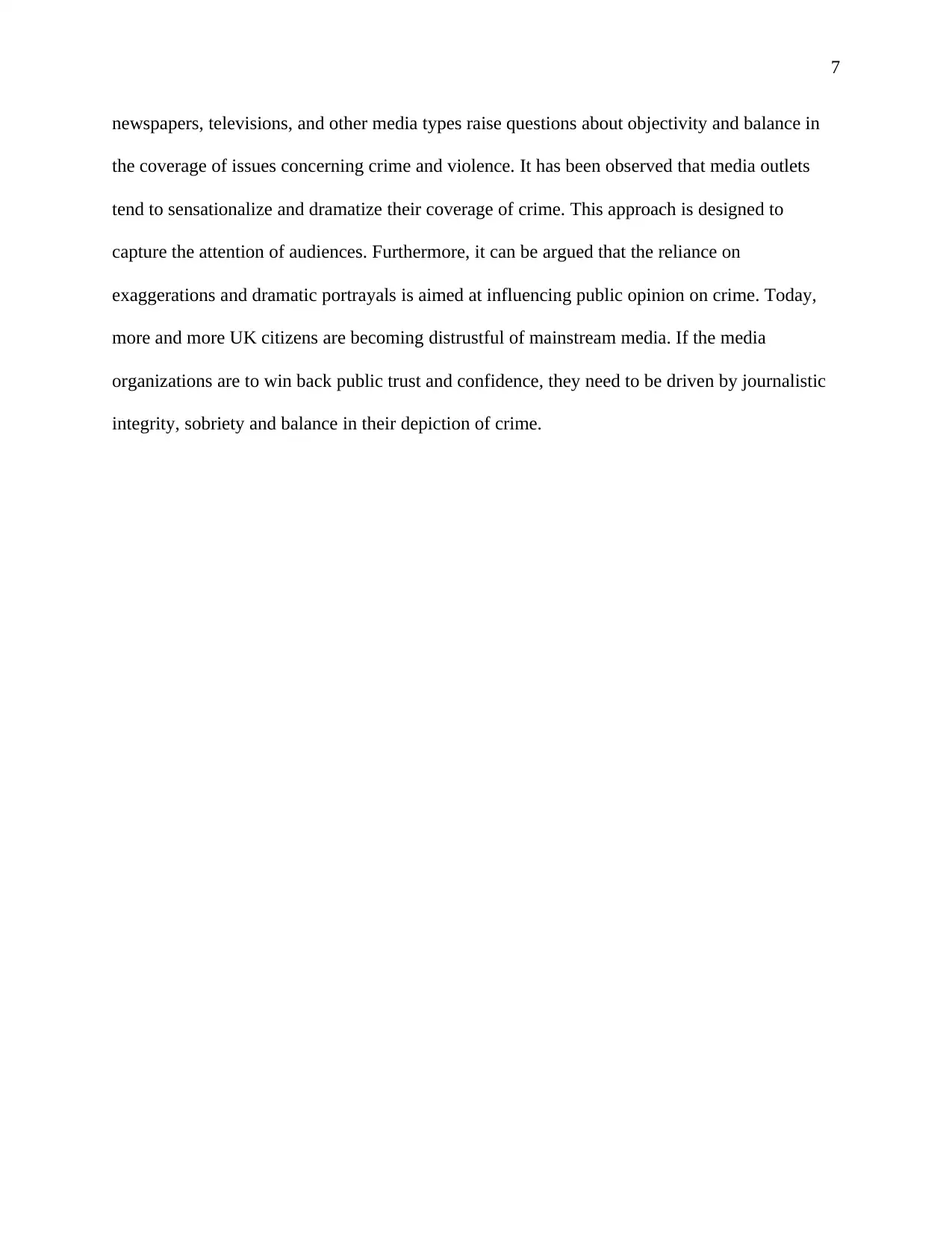
7
newspapers, televisions, and other media types raise questions about objectivity and balance in
the coverage of issues concerning crime and violence. It has been observed that media outlets
tend to sensationalize and dramatize their coverage of crime. This approach is designed to
capture the attention of audiences. Furthermore, it can be argued that the reliance on
exaggerations and dramatic portrayals is aimed at influencing public opinion on crime. Today,
more and more UK citizens are becoming distrustful of mainstream media. If the media
organizations are to win back public trust and confidence, they need to be driven by journalistic
integrity, sobriety and balance in their depiction of crime.
newspapers, televisions, and other media types raise questions about objectivity and balance in
the coverage of issues concerning crime and violence. It has been observed that media outlets
tend to sensationalize and dramatize their coverage of crime. This approach is designed to
capture the attention of audiences. Furthermore, it can be argued that the reliance on
exaggerations and dramatic portrayals is aimed at influencing public opinion on crime. Today,
more and more UK citizens are becoming distrustful of mainstream media. If the media
organizations are to win back public trust and confidence, they need to be driven by journalistic
integrity, sobriety and balance in their depiction of crime.
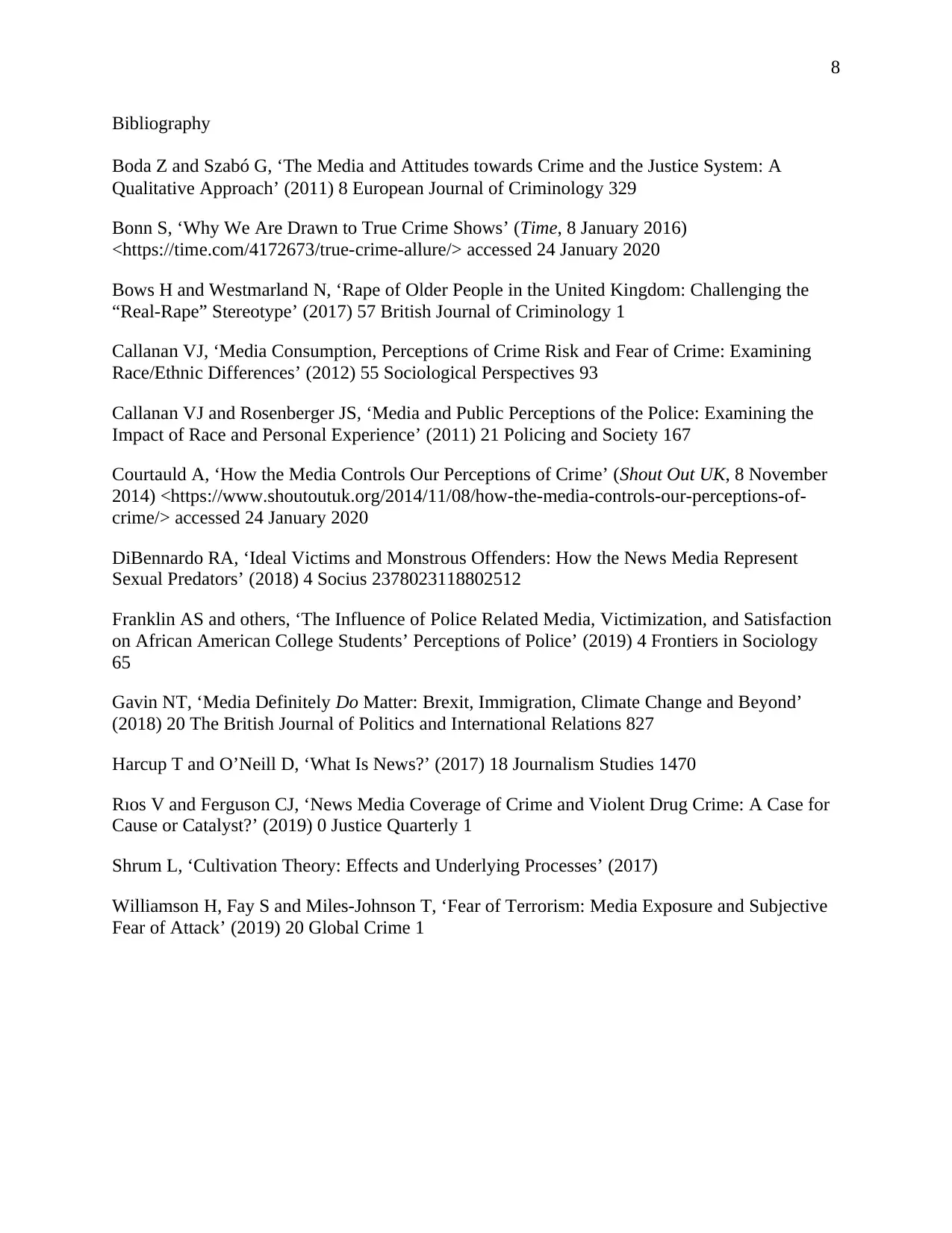
8
Bibliography
Boda Z and Szabó G, ‘The Media and Attitudes towards Crime and the Justice System: A
Qualitative Approach’ (2011) 8 European Journal of Criminology 329
Bonn S, ‘Why We Are Drawn to True Crime Shows’ (Time, 8 January 2016)
<https://time.com/4172673/true-crime-allure/> accessed 24 January 2020
Bows H and Westmarland N, ‘Rape of Older People in the United Kingdom: Challenging the
“Real-Rape” Stereotype’ (2017) 57 British Journal of Criminology 1
Callanan VJ, ‘Media Consumption, Perceptions of Crime Risk and Fear of Crime: Examining
Race/Ethnic Differences’ (2012) 55 Sociological Perspectives 93
Callanan VJ and Rosenberger JS, ‘Media and Public Perceptions of the Police: Examining the
Impact of Race and Personal Experience’ (2011) 21 Policing and Society 167
Courtauld A, ‘How the Media Controls Our Perceptions of Crime’ (Shout Out UK, 8 November
2014) <https://www.shoutoutuk.org/2014/11/08/how-the-media-controls-our-perceptions-of-
crime/> accessed 24 January 2020
DiBennardo RA, ‘Ideal Victims and Monstrous Offenders: How the News Media Represent
Sexual Predators’ (2018) 4 Socius 2378023118802512
Franklin AS and others, ‘The Influence of Police Related Media, Victimization, and Satisfaction
on African American College Students’ Perceptions of Police’ (2019) 4 Frontiers in Sociology
65
Gavin NT, ‘Media Definitely Do Matter: Brexit, Immigration, Climate Change and Beyond’
(2018) 20 The British Journal of Politics and International Relations 827
Harcup T and O’Neill D, ‘What Is News?’ (2017) 18 Journalism Studies 1470
Rıos V and Ferguson CJ, ‘News Media Coverage of Crime and Violent Drug Crime: A Case for
Cause or Catalyst?’ (2019) 0 Justice Quarterly 1
Shrum L, ‘Cultivation Theory: Effects and Underlying Processes’ (2017)
Williamson H, Fay S and Miles-Johnson T, ‘Fear of Terrorism: Media Exposure and Subjective
Fear of Attack’ (2019) 20 Global Crime 1
Bibliography
Boda Z and Szabó G, ‘The Media and Attitudes towards Crime and the Justice System: A
Qualitative Approach’ (2011) 8 European Journal of Criminology 329
Bonn S, ‘Why We Are Drawn to True Crime Shows’ (Time, 8 January 2016)
<https://time.com/4172673/true-crime-allure/> accessed 24 January 2020
Bows H and Westmarland N, ‘Rape of Older People in the United Kingdom: Challenging the
“Real-Rape” Stereotype’ (2017) 57 British Journal of Criminology 1
Callanan VJ, ‘Media Consumption, Perceptions of Crime Risk and Fear of Crime: Examining
Race/Ethnic Differences’ (2012) 55 Sociological Perspectives 93
Callanan VJ and Rosenberger JS, ‘Media and Public Perceptions of the Police: Examining the
Impact of Race and Personal Experience’ (2011) 21 Policing and Society 167
Courtauld A, ‘How the Media Controls Our Perceptions of Crime’ (Shout Out UK, 8 November
2014) <https://www.shoutoutuk.org/2014/11/08/how-the-media-controls-our-perceptions-of-
crime/> accessed 24 January 2020
DiBennardo RA, ‘Ideal Victims and Monstrous Offenders: How the News Media Represent
Sexual Predators’ (2018) 4 Socius 2378023118802512
Franklin AS and others, ‘The Influence of Police Related Media, Victimization, and Satisfaction
on African American College Students’ Perceptions of Police’ (2019) 4 Frontiers in Sociology
65
Gavin NT, ‘Media Definitely Do Matter: Brexit, Immigration, Climate Change and Beyond’
(2018) 20 The British Journal of Politics and International Relations 827
Harcup T and O’Neill D, ‘What Is News?’ (2017) 18 Journalism Studies 1470
Rıos V and Ferguson CJ, ‘News Media Coverage of Crime and Violent Drug Crime: A Case for
Cause or Catalyst?’ (2019) 0 Justice Quarterly 1
Shrum L, ‘Cultivation Theory: Effects and Underlying Processes’ (2017)
Williamson H, Fay S and Miles-Johnson T, ‘Fear of Terrorism: Media Exposure and Subjective
Fear of Attack’ (2019) 20 Global Crime 1
1 out of 9
Your All-in-One AI-Powered Toolkit for Academic Success.
+13062052269
info@desklib.com
Available 24*7 on WhatsApp / Email
![[object Object]](/_next/static/media/star-bottom.7253800d.svg)
Unlock your academic potential
© 2024 | Zucol Services PVT LTD | All rights reserved.